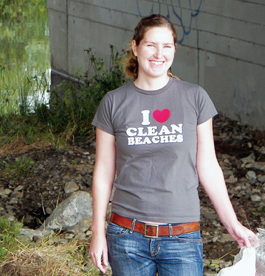home | metro santa cruz index | news | santa cruz | news article

Photograph by Jessica Lussenhop
Take Me To The River: Save Our Shores" cleanup coordinator, Emily Glanville, says inland waterways are a major source of marine pollution.
Coastal Cleanup Day Swims Upstream
While the beaches get cleaner, the rivers keep getting dirtier--and that makes Emily Glanville"s job a lot tougher.
By Jessica Lussenhop
AS COASTAL Cleanup Day gears up for its 25th anniversary of beachcombing for cigarette butts and bottles, Save Our Shores marine debris program coordinator Emily Glanville says there"s good news and there"s bad news.
"Our beaches are looking pretty good these days," she says. "We"re seeing less trash being left on the beach. Our data from the summer of 2008 showed quite a bit more."
Glanville says the comeliness of our coast is likely due to Save Our Shores" more regular schedule of cleanups--two or three per week--but the sheer volume of trash has shrunk as well, a sign that people"s bad habits might really be changing. Of course, there"s still plenty of trash to go around, and Coastal Cleanup in Santa Cruz is starting to set its sights slightly further inland.
"We"ve added a number of river cleanup sites. It"s become really apparent that"s where the bulk of the debris is," she says.
According to last year"s data, the three dirtiest sites in the county were all riverfront property. Struve Slough at Ramsey Park in Watsonville coughed up 1,677 pounds of trash, the Pajaro River at River Park had 1,200 pounds and the San Lorenzo River site at the Water Street Bridge yielded 750 pounds. That"s about 35 percent of the day"s total take of 10,200 pounds of trash countywide from just three out of 45 sites.
"We"re shocked by what we"re finding," says Glanville. "Things like sofas and dishwashing machines and toilet bowls and screen doors. It looks like people are literally dumping what they don"t want in these river areas because they can be easily hidden behind brush."
But focusing more on inland waterways has its own set of complications.
"It"s harder for us to get volunteers. There"s poison oak, there"s really bad access, dangerous trails, if there are trails," she says. Cleaning up a slough doesn"t have the same charm of a day at the beach, and it also brings up the sticky issue of homeless encampments and the particular kind of trash that comes with them.
"Rivers do present different challenges in terms of human waste and drug paraphernalia. There"s a lot of yucky stuff going on along the riverways," says Ocean Conservancy director of Pacific Ecosystems Protection Kaitilin Gaffney. Though she estimates only about 10 percent of the overall garbage is a direct result of homelessness on the rivers, Gaffney knows firsthand that it is a delicate issue, since her husband has been the cleanup site coordinator for the San Lorenzo River in the past.
"You give the homeless their space," she says. "People are not using the river as a toilet because they have a choice. The city and the county and the state need to come up with solutions for those problems."
Glanville says she hopes a sufficient number of the expected 4,000 volunteers will be OK if their assignment is landlocked and that they"ll understand the direct link between the health of the rivers and the health of the coasts.
"People always complain about why their kids can"t swim at the mouth of the San Lorenzo or at the mouth of Aptos Creek. That"s all a symptom of what"s upriver," she says. "Our ocean is our lowest point. Everything is flowing out to the ocean." And she does mean everything.
Though a long-term solution to the problem of people living along the river is slightly outside the purview of an environmental cleanup campaign, Gaffney says raising awareness the problem areas around rivers is a powerful tool.
"I think the solution for many of the problems is to get more people out there using it," she says. "Make it beloved."
THE 25TH ANNUAL COASTAL CLEANUP DAY is Saturday, Sept. 19, from 9am to noon. For more information or to sign up, call Save Our Shores at 831.462.5600 or visit www.saveourshores.org.
Read news updates daily at www.santacruz.com/news.
Send a letter to the editor about this story.
|
|
|
|
|
|